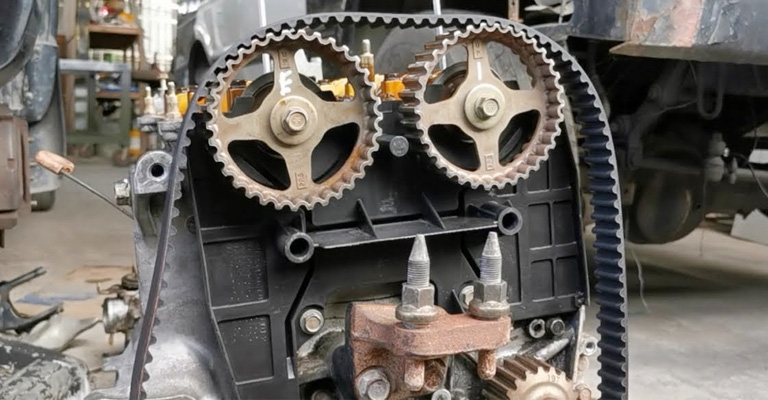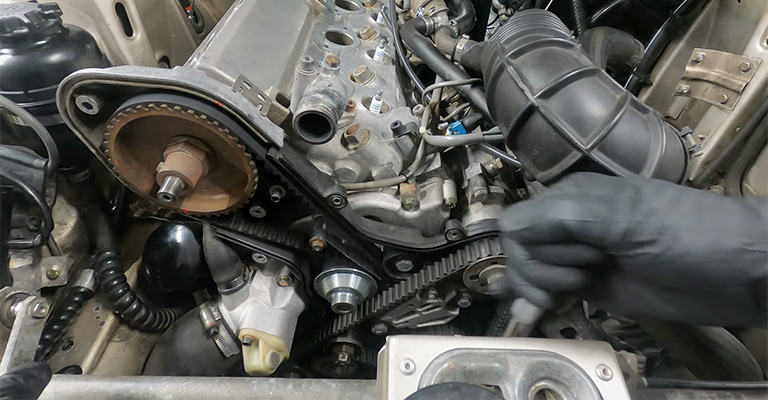The tension of the engine belt must be in a balanced condition. Too high tension will damage the engine. On the other hand, too low tension will cause the belt to slip.
So how do you adjust the tension on a honda timing belt? The steps are pretty straightforward. First, locate the timing belt, get the pistons in the dead-center position, switch the bolt, adjust the belt tension, and repeat the tasks for other crank turns.
Not wanting to tarry any longer, let’s adjust the Honda’s timing belt. If you want a thorough understanding of the subject, read the entire article.

How Do You Adjust The Tension On A Honda Timing Belt? (Explained)
In most cases, there is no prior indication that your timing belt needs replacing. There isn’t even a squeak to signal when the time has come. After the engine runs smoothly, it can clunk and stop, and it won’t start again.
If the engine’s timing is off, the valves and pistons will smash into each other, causing extensive and costly damage. So before replacing a broken timing belt, check to see if the valves have been damaged.
Components That You Need

- 12mm socket
- 3/8 ratchet
- 14 mm socket
- 10mm deep socket
- 2″ extension
- 19 mm socket
The process is so easy that there’s no need to jack the car up. Follow up the below steps to find the desired result
Step 1: Locate the timing belt
First of all, find the engine’s timing belt. The belt should be on the upper edge of the engine on the driver’s side. Upper timing covers typically have two bolts- one at the front and one at the back. That must be undone, and the covers separated.
Step 2: Get the pistons in the dead-center position

Get the pistons in their top-most, dead-center positions. The top-dead-center position can be achieved in two ways. The first is by aligning the white hash logo on the harmonic balancer/accessory pulley. And the second way is by aligning the cam marks on the camshaft with the top of the engine head.
As a result, the crank bolt is turned with a ratchet and socket of 19 mm. You’ve uncovered a serious problem, so when finished, retorque to specifications
Remove yourself after disconnecting the PS pump. A ratchet could squeeze into the bay with this much. A deep socket might be required.
Step 3: Switch bolts and adjust the belt tension
A rubber plug can be found under the engine mount on the driver’s side. It must be taken off by hand. The inside of the case will have a 14mm fasteners head for your pulley tensioning bolt. Switch the bolt to 180 degrees clockwise with a 14mm connector to loosen it.
When adjusting the belt tension, employ a 19mm connector to turn the crank counterclockwise by three teeth on the cam. Turning the crank clockwise will cause the tensioner to pull in the opposite direction, causing the belt to become looser.
If you don’t have a torque wrench, use a 14mm socket to tighten the tensioner bolt to 33-40ft/lb. The oil filter only needs to be snugged on with 33 ft/lb.
Step 4: Turn and Repeat

Turn the crank CLOCKWISE with the 19mm socket, Repeat this process for another 5-6 crank turns, and then return to TDC.
Re-check finger tension and switch out the PS pump’s belt. Moreover, switch out the VC nuts for 10 mm ones, then leave and go for a drive.
Bonus Tip
Always double-check your results when you’re done! To do this, use the wrench to lift the belt off the crankshaft and give the engine a full two revolutions. See to it that the pistons and valves are not touching each other and that the belt has no resistance.
Put the cover back on when everything is fine and tighten the bolts. Do not over-tighten them! Don’t forget to reconnect the battery cables before you close the hood. Congratulations, you are ready to go!
Timing Belt Issue Signs

Although both timing belts and chains can break and cause significant damage, timing belts tend to break more frequently. Look for telltale symptoms if your timing belt starts to wear out.
Weird Noises
When a timing belt begins to wear out, it makes a distinctive noise that is unlike the majority of other sounds you’ll hear while working on your car. When the teeth on your timing belts degrade or fall off, they will make a rapid, reoccurring ticking noise as it spins.
While the timing belt is also a possible source, the serpentine belt is more often to blame for this sporadic rather than constant occurrence. It’s possible to hear it at any time during operation, from when the engine is first started to when it’s accelerating.
Faulty Engine
The camshaft and crankshaft are kept in time with one another and with the exact timing of one’s engine, thanks to the timing belt. Timing belts fail when their teeth wear out, preventing them from gripping their gears securely and leading to a breakdown like that seen in the recalled Hondas this year.
It’s very comfortable and easy to take off or unwind in. That can radically alter your engine’s timing, preventing the combustion reaction from occurring at the optimal time. An engine misfire occurs when the valves open too early, the fuel is injected too late, or the spark happens at the wrong time.
Substantial Oil Losses
The cover for your timing belt is secured with bolts, and these bolts may work their way loose over time. If this happens, oil could spill out onto the driveway below your car or into the engine bay. Furthermore, oil can seep over onto the timing belt and damage it. Because of this, the timing belt may wear out prematurely!
What is the Price Of A New Timing Belt For Your Honda?
Timing belt replacement is a high-priced chore for most people. However, the answer also depends on your car’s make, model, and model year, as well as the repairman you take it to.
For instance, if you own a Honda Accord, you can expect to pay around $500 and $700 to replace the timing belt. Prices can range from around $1,000 to $1,500 for more expensive models.
FAQs
The followings are some frequently asked questions related to the timing belt tension.
How frequently should you tighten the timing belt?
Every 10,000 miles or so, you should check and adjust your chain as a basic piece of maintenance.
What role does chain tension play in shifting?
When the cable tension is too low, the upshift is slow, and when it is too high, the downshift is slow.
Conclusion
Timing belts manufactured by Honda are widely regarded as among the most reliable in the industry. If you want to know how do you adjust the tension on a honda timing belt, you can read the entire article to get a rough knowledge.
The process needs to be done with core knowledge. You should have a pro make the timing belt tension adjustment if you aren’t familiar with working on engines.

Leave a Reply